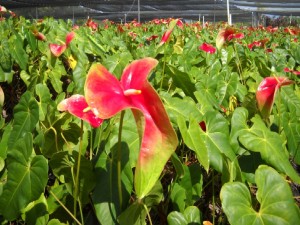Kalapana Anthurium
Kalapana was a beautiful black sand beach in Hawaii that was known for its pounding surf and huge coconut trees. I say “was” because it no longer exists. Kalapana was consumed by fiery lava after the Kilauea volcano began erupting back in the eighties.
I suspect Kalapana obake anthurium flowers were named after this beach that was consumed by fire. Perhaps because they come in a fiery shade of red that might symbolize lava and they are tinged with green that might symbolize the coconut trees that used to grace this amazing beach that only exists in our memories and photos.
The Kalapana anthurium plant is a great plant to grow because it tends to be resistant to the blight, which is the bane of many varieties of anthuriums. And it also is resistant to anthracnose, which tends to destroy flowers.
And Kalapana is slowly being reborn as the waves tirelessly pulverize the new lava flow into ebony sand and gracious people replant tiny coconut seedlings one by one.
Hokuloa Anthurium
Hokuloa Anthurium Flowers were developed by the University of Hawaii. The university crossed an A. antioquiense with a Marian Seefurth to produce a hybrid. Then they took this hybrid and then crossed again with Tropic Mist. The end result was the Hokuloa Anthurium.
The Hokuloa anthurium flower comes in a gorgeous shade of white. It has a yellow nose that turns white as the flower matures.
Did you know that Hokuloa means morning star in Hawaiian? And of course morning star is a reference to the planet Venus, which is one of the brightest objects in the sky. Venus manages to outshine all of the stars in the sky by reflecting massive amounts of sunlight towards us.
The Hokuloa is almost as brilliant as its namesake. Its flowers are almost resplendent enough to blind you if you don’t wear sunglasses. (Okay, maybe I’m going a little overboard, but it is a beautiful flower.)




